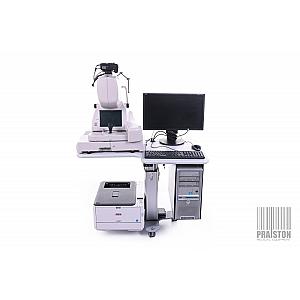The Topcon 3D OCT 2000 Optical Coherence Tomography distinguishes itself as a high-resolution fundus camera with a touchscreen interface, delivering a user-friendly encounter in a compact configuration. It provides intricate OCT scans and includes a spacious HP monitor for improved visualization.
OCT 3D OCT 2000 - Perfect Condition











Offer Details
Accessories :
Power cord, Fixation point, Wired keyboard, Wired mouse, Dedicated protective rubber for the lens, Monitor,
Seller Warranty :
6-months for domestic market (Poland), 3-months for the international market,
Description
Topcon OCT 2000: Precision Imaging and Effortless Operation for Optimal Eye Care Examinations
The Topcon 3D OCT 2000 Optical Coherence Tomography stands out as a high-resolution fundus camera equipped with a touchscreen interface, providing a user-friendly experience in a compact design. It offers detailed OCT scans and features a large HP monitor for enhanced visualization.
For eye care professionals seeking precision and quality in every examination, the Topcon OCT 2000 proves to be an optimal choice. It caters to practices of all sizes with its high-resolution imaging capabilities. The model prioritizes simplicity in operation, allowing operators to establish examination parameters effortlessly with a touch of a button.
The Topcon OCT 2000 introduces 3D imaging with a wide scan angle, capturing peripheral aspects of the macula and disc. This feature enhances the assessment tool, facilitating quicker detection of macular conditions like glaucoma. The model's templates are user-friendly, providing easy-to-read reports for patients to comprehend their conditions and treatment options.
Key features and benefits of the Topcon OCT 2000 include its automated functions, requiring minimal interference during examinations. Automated disc searches and detection functions contribute to precise scan placement. Glaucoma-specific and macula-specific reporting options offer flexibility, enabling efficient examinations with shorter exposure times for patients.
The Topcon OCT 2000 emphasizes ease of use, making it accessible even for clinicians with minimal understanding of OCT systems. With just four basic steps, including patient registration, scanning pattern selection, examination initiation, and result review, the model simplifies the entire process. The motorized joystick controller enhances efficiency, allowing non-distracted adjustments for precision movements during examinations.
The model's high-quality output is driven by its capability to perform 50,000 A-scans per second, providing detailed results in a short time. With a wide scan surface and higher resolution images, clinicians can tailor scans to meet varying patient needs. This versatility enables clinicians to focus on simple overviews or detailed examinations based on individual patient requirements, enhancing overall efficiency and performance.
Features
- FastMap™ software enables dynamic viewing of 2D, 3D and fundus images simultaneously
- Embedded touch-screen for quick and easy navigation
- Automated image acquisition process (auto-focus, auto-shoot)
- Data from Stratus® OCT and 3D OCT-1000 can be easily imported, analyzed and viewed
- 2 in 1 system is space-saving and economical
- Combined diagnosis with PinPoint™ registration of the OCT image within the fundus image
- Compare function allows for serial monitoring of OCT images
- Complete Windows 7 Software
- Large HD monitor
Technical Details
Dimensions: 545 (W) x 535 (D) x 600-630 (H) mm
Weight: 35 kg
Power Supply: 100 - 240 V AC, 50/60 Hz
Power Consumption: 200 VA (Max 400 VA)
Compatible Accessories
See Brochure